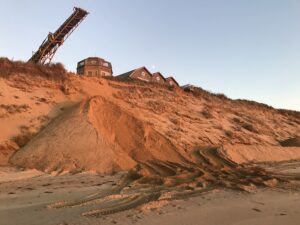WELLFLEET — The massive house on the edge of the eroding bluff at 1440 Chequessett Neck Road is a cliff-hanger in more than one way.

In January, the town’s conservation commission expected the house’s owner, New York attorney John G. Bonomi, to present plans for dismantling it. But Bonomi decided to “walk away” from any responsibility for addressing the house’s precarious situation, according to his lawyer. Instead, he wants the town to deal with it. Meanwhile, one big storm could push it over the brink.
Mark Borrelli, a coastal geologist with the Center for Coastal Studies, said the house will surely fall to the beach if it is not removed from the bluff. “It’s only a matter of time, but it won’t be long, and it could be this winter,” Borrelli said.
Wellfleet officials have been working on a response since mid-January, when the lawyer for Bonomi, who bought the troubled property for $5.5 million in 2021, told the conservation commission that his client had conveyed it to CQN Salvage LLC and no longer had any involvement in it.
The lawyer, Thomas Moore, who said he represented both Bonomi and CQN, said neither of his clients planned to pay the $1 million he claimed it would cost to demolish the structure, so its fate was in the hands of the town.
CQN would strip “items and materials” inside the house until erosion made the structure too unstable, Moore said. The house’s current situation could have been prevented, he claimed, if the commission had allowed construction of the 241-foot stone revetment the previous owner had proposed. That denial was upheld in Barnstable Superior Court; the case is now before the state appeals court.
While local officials hope to force the owner to demolish the structure, it is uncertain whether that can be accomplished in time.
Borrelli was baffled by the owner’s refusal to take responsibility for the house, leaving it to slide into the bay. “It’s ridiculous,” he said. “It sounds like somebody saying, ‘I’m going to pull the trigger, but whatever happens after the bullet leaves the muzzle is not my problem.’ ”
In a phone interview on Feb. 9, select board chair John Wolf said his board has planned an executive session with the conservation dept. and the town’s attorney at the start of its Feb. 18 meeting to discuss legal steps and will update the public following the closed-door session.
“It is my hope and expectation that we will be exploring all possible avenues of harm,” said Wolf, referring to the damage the collapse of the house could cause.
Attorney Bruce Bierhans, who lives in Wellfleet but is not involved in the case, told the Independent that the town’s options “begin with the issue of whether the danger of the house falling off the cliff constitutes an imminent harm to public health and whether it presents an imminent harm to the economy of the community.” To successfully argue that those threats are imminent, the town will have to have the science and engineering to support its position, he said.
Once the town establishes imminent harm, officials can seek a preliminary injunction whereby the court would order the property owner to demolish the house, according to Bierhans. “The bottom line is the town has to take an aggressive posture toward requiring that something be done before potentially permanent damage is done not only to the town but the economy of the region,” he said.
Conservation commissioner John Cumbler told the Independent that if the house were to fall into the bay, the current would carry the material, including toxic debris like insulation, into Wellfleet Harbor, contaminating oyster beds and threatening Wellfleet’s shellfish industry.
At a conservation commission meeting last fall, Shellfish Constable Nancy Civetta expressed similar concerns, saying that about 10 percent of year-round residents in town make their living from shellfishing. The town has 121 shellfish farms, 160 grants, 142 grant holders, 91 wild pickers, and over 1,000 recreational shellfishermen, Civetta told the commission, according to minutes of that meeting.
Borrelli said debris from the house could cause several problems beyond potential damage to the harbor. “I’m not a construction guy, but I’ve got to believe there are all kinds of chemicals in the house that you don’t want floating around in the ocean,” he said. “I mean, there are seals and fish and shellfish and eelgrass beds out there.”
Select board member Sheila Lyons characterized the property owner’s position as “a sign of the times,” pointing out that Bonomi bought the property knowing the previous owner had been denied a stone revetment by the town.
Lyons is frustrated that this financial responsibility is being dumped on the town. She doesn’t buy the idea that Bonomi’s sale of the house to CQN is legitimate. “It seems to me like his lawyer just set up this shell company,” she said. As of press time, the transfer of the house still had not appeared on record at the Barnstable County Registry of Deeds.
On New York State’s online corporations database, CQN Salvage LLC has no officers listed. It includes only a mailing address for “The LLC” in Flushing, N.Y. An online check by the Independent showed the address belongs to a firm called Coran Ober. No one at the firm responded to an email from a reporter.
“Unfortunately, this is going to the courts to be decided, and the house could be gone by the time we have the result,” Lyons said.
The house at 1440 Chequessett Neck was built in 2010 by the property’s previous owners, Mark and Barbara Blasch, and is known to many as “the Blasch house.” In 2018, as erosion carved away the bluff, the Blasches asked to construct a stone revetment on the bay. The town denied the request based on wetlands protection laws, in place since 1978, that regulate coastal erosion structures.
When the Superior Court upheld the denial in 2023, Bonomi put the house up for sale, but there were no takers. He then took it off the market.
Lyons said the Bonomi house isn’t the only one affected by erosion. Those who walk the beaches see what’s happening, she said, adding that several houses on the ocean side in Wellfleet could soon face similar circumstances.
“That’s all the more reason that we really have to fight this,” she said. “Everybody will walk away from these things if we don’t enforce their responsibility.”



